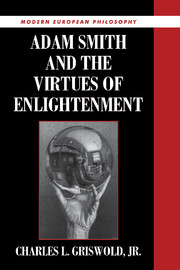Book contents
- Frontmatter
- Contents
- Texts and Acknowledgments
- Introduction
- 1 Rhetoric, Method, and System in The Theory of Moral Sentiments
- 2 Sympathy and Selfishness, Imagination and Self
- 3 The Passions, Pleasure, and the Impartial Spectator
- 4 Philosophy and Skepticism
- 5 The Theory of Virtue
- 6 Justice
- 7 The Moral Sentiments and The Wealth of Nations
- 8 Philosophy, Imagination, and the Fragility of Beauty: On Reconciliation with Nature
- Epilogue
- Bibliography
- Index
2 - Sympathy and Selfishness, Imagination and Self
Published online by Cambridge University Press: 10 November 2009
- Frontmatter
- Contents
- Texts and Acknowledgments
- Introduction
- 1 Rhetoric, Method, and System in The Theory of Moral Sentiments
- 2 Sympathy and Selfishness, Imagination and Self
- 3 The Passions, Pleasure, and the Impartial Spectator
- 4 Philosophy and Skepticism
- 5 The Theory of Virtue
- 6 Justice
- 7 The Moral Sentiments and The Wealth of Nations
- 8 Philosophy, Imagination, and the Fragility of Beauty: On Reconciliation with Nature
- Epilogue
- Bibliography
- Index
Summary
What we are supplying are really remarks on the natural history of human beings; we are not contributing curiosities however, but observations which no one has doubted, but which have escaped remark only because they are always before our eyes.
Ludwig WittgensteinThe Theory of Moral Sentiments is a theory of the “passions,” “sentiments,” or “emotions.” To what question, or questions, is this theory a response? Part VII informs us that any theory of moral sentiments proposes to answer two questions. The first is, in short: “Wherein does virtue consist?” The second concerns the means by which this or that “tone of temper, and tenour of conduct” come to recommend themselves to us as virtuous or not; that is, it concerns moral psychology. In this chapter and the next I shall focus on Smith's answer to the second question. I begin with his account of sympathy, for that notion is central to his theory of moral sentiments. What exactly does he mean by “sympathy”? How are sympathy and selfishness to be distinguished? Why is sympathy central to ethics, on Smith's view?
In order to answer these questions, we need to understand his distinction between “agent” (or “actor”) and “spectator,” as well as the priority he gives to the latter. I shall explore a potential instability in his notion of sympathy: it may seem that, pressed in one direction, sympathy is possible only within narrowly defined social circles, for reasons that would make impossible the objective evaluation that ethics requires. After examining Smith's defense of sympathy against such objections, I conclude with discussion of the pathos entailed by the fundamentally “theatrical” relation between actor and spectator.
- Type
- Chapter
- Information
- Adam Smith and the Virtues of Enlightenment , pp. 76 - 112Publisher: Cambridge University PressPrint publication year: 1998



